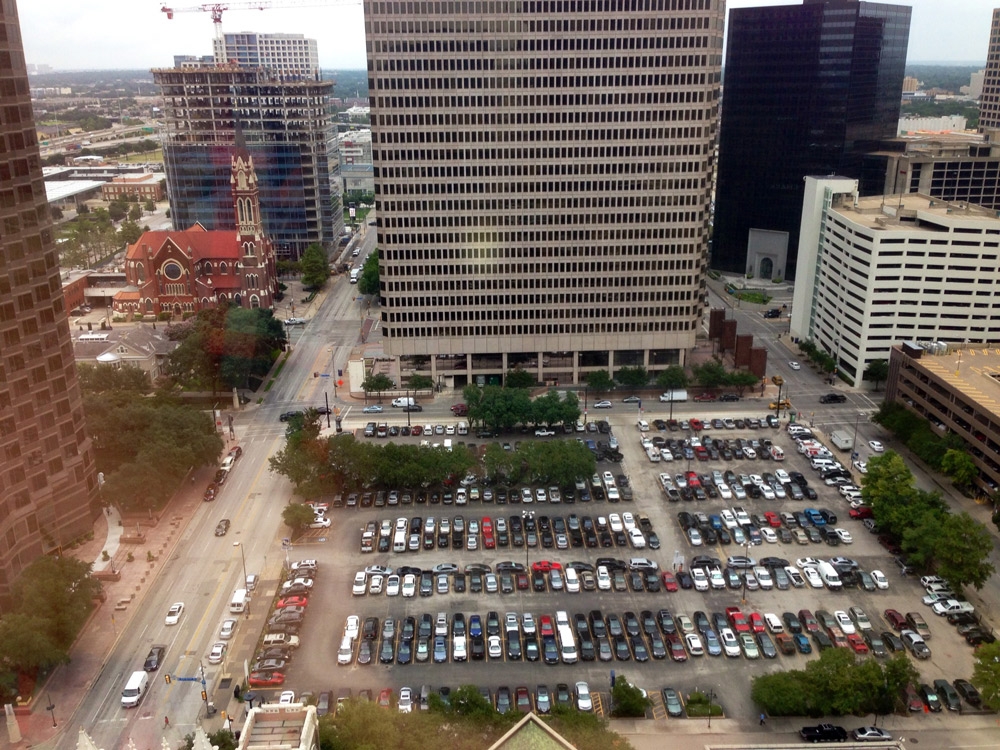
Here we go again. Dallas is worried it has a downtown parking problem. In the wake of the update of the downtown 360 study, the city now wants to hire a consultant to tell us how to fix this perennial impediment to downtown’s success.
I don’t have much to add to Mark Lamster’s assessment of the plan. As the DMN’s architecture critic argues, the move to hire a parking consultant completely misses the point. “Dallas doesn’t principally have parking problem” Lamster writes. “It has a downtown Dallas problem.”
The reason there is a logical disconnect between those who argue that downtown is a sea of empty parking lots and those who argue that there isn’t enough parking is that we continue to see parking as a cause of downtown’s shortcomings, rather than symptom. Lamster argues that rather than addressing parking, downtown boosters and the city should focus on improving the things that make downtown unique:
The very assumptions of the study are at issue. Why is it so absolutely crucial that there be so much parking, and that it be so close to developments? Because the sidewalks are crumbling and blocked, because there isn’t shade, because the signals and crossings are designed for automobiles not people, because there are empty lots that are ugly and appear dangerous, because there is a homeless problem that seems intractable only for lack of resources.
All that parking is crucial because we don’t have effective public transit, with buses that move rapidly and predictably and an efficient light-rail system.
The only way to solve the parking problem in Downtown Dallas is to resolve these issues.
Lamster’s right about the need to improve downtown’s infrastructure so that walking from available parking and using public transit are what make working in downtown appealing than leasing in the suburbs. But there’s another side of the challenge that’s worth mentioning.
The whole problem with parking downtown boils down to the skyline. Even though downtown is doing better than it ever has in decades, there is still a ton of space to fill in the city’s largest buildings, which have historical under-performed when compared with other cities. At the same time, historically low vacancy rates downtown have created increased demand for parking. It’s a catch-22. While the appeal of downtown’s urban setting has attracted more people to it, it creates a market pressure to expand the kind of use – parking – that detracts from that setting.
Another way to put this: downtown Dallas doesn’t have a parking problem, it has a market problem. In the 1980s, a skyline building race created false density downtown, millions of square footage than the area has never really been able to support. That facilitated the infrastructure problem: the height of the skyscrapers echoed in the breadth of the empty parking lots at their feet.
Now we want to back-fill those empty skyscrapers without crushing the urban environment that is making them attractive again.
Better infrastructure will help. We should improve our streetscapes, make office buildings more accessible through alternate forms of transportation, and expand living options downtown so more people work and live there. But if the essential problem downtown is an excess of commercial office space that the market can’t support without more parking, then the problem can’t be fixed merely by addressing infrastructure, we also have to tackle land use.
We’re stuck with our skyscrapers. I don’t see anyone demolishing one of the big boys anytime soon. But perhaps they wouldn’t exert such a pressure on the need for parking downtown if we began to think of them not as empty office space, but as structures that could be rethought in compelling new ways.
The hot downtown residential and hotel market has prompted some adaptive reuse of office buildings, and there’s no reason to think that trend won’t continue. But perhaps there are other ideas that could accelerate that conversion or offer other uses to retrofit into our skyscrapers. For example, what about turning a portion of a skyscraper into a top-notch public school for downtown residents? That’s a use that would require less parking than the typical 3 spaces per 1,000 square-feet offered by landlords in the suburbs, while only further driving the demand for more residential conversion of downtown buildings.
It is somewhat disheartening that the rethinking of the downtown 360 plan resulted in a call for a parking consultant. Urban planning initiatives like downtown 360 offer the opportunity to think outside the box, to stare old problems in the face and recognize them for what they are and dare to come up with bold new ways of addressing them.
The parking problem downtown is a function of the continued effort to shore up a suburban office leasing model in a rapidly transforming downtown market. What the city should hire is not someone who can figure out the parking situation, but someone who can bring new ideas to how to promote an adaptive reuse of the skyscrapers. We should be coming up with ways to shore up these real estate assets as investments, while back-filling them with uses that don’t require more parking.




